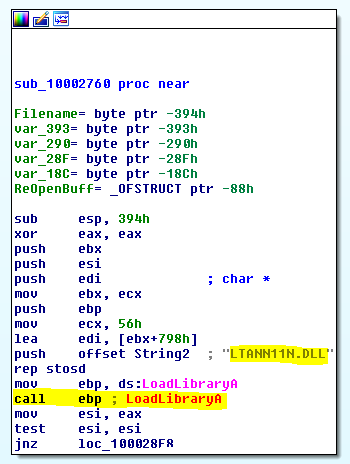Abstract
Multiple DLL side loading vulnerabilities were found in the LEADTOOLS ActiveX control. These issues can be exploited by loading various COM components as an embedded OLE object. When instantiating the object Windows will try to load the DLL LTANN11N.DLL from the current working directory. If an attacker convinces the user to open a specially crafted (Office) document from a directory also containing the attacker's DLL file, it is possible to execute arbitrary code with the privileges of the target user. This can potentially result in the attacker taking complete control of the affected system.
Affected versions
This issue was successfully verified on the HP Color LaserJet CM2320 MFP drivers version 3.1 (CM2320series-win7-full-solution-AM-EMEA1-v3.1.exe).
Fix
There is currently no fix available, HP reports: "Unfortunately, the driver software for these devices can no longer be updated. The devices have ended support life and the engineering resources are no longer available to provide any firmware updates. We do understand the issue, and current drivers are no longer vulnerable to the OLE side load issue".
Introduction
OLE is a technology that enables an application to create compound documents that contain information from a number of different sources. For example, a document in an OLE-enabled word processor can accept an embedded spreadsheet object. Unlike traditional "cut and paste" methods where the receiving application changes the format of the pasted information, embedded documents retain all their original properties. If the user decides to edit the embedded data, Windows activates the originating application and loads the embedded document.
OLE objects are loaded via a CLSID or indirectly via a programmatic identifier (ProgID). The CLSID is used to look up its associated DLL in the Windows Registry. In order to check if the provided CLSID is in fact an OLE object, this DLL needs to be loaded in memory first, even if the CLSID is not really an OLE object. Since the DLL may not be designed to be loaded this way, loading it can introduce security issues like side loading of malicious DLLs.
Vulnerability details
It was discovered that the LEADTOOLS ActiveX control is affected by multiple DLL side loading vulnerabilities. The following COM components are affected by this issue:
- LEAD Main Control (11.0) (CLSID
{00110000-B1BA-11CE-ABC6-F5B2E79D9E3F}) - LEAD.AnnToolbar.110 (CLSID
{00110005-B1BA-11CE-ABC6-F5B2E79D9E3F}) - LEAD.AnnMenu.110 (CLSID
{00110007-B1BA-11CE-ABC6-F5B2E79D9E3F})
These controls are implemented in the DLL ltocx11n.ocx. When one of these controls is instantiated, this DLLs calls LoadLibraryA("LTANN11N.DLL"), which causes the LTANN11N.DLL to be loaded from the current working directory.
 Figure 1: LEADTOOLS ActiveX control loads
Figure 1: LEADTOOLS ActiveX control loads LTANN11N.DLL from a relative path
An attacker can exploit this issue by convincing a target user into opening a specially crafted (Office) document from a directory containing the attacker's DLL. This allows for the execution of arbitrary code that will be executed with the privileges of the target user, potentially resulting in a full compromise of the affected system.